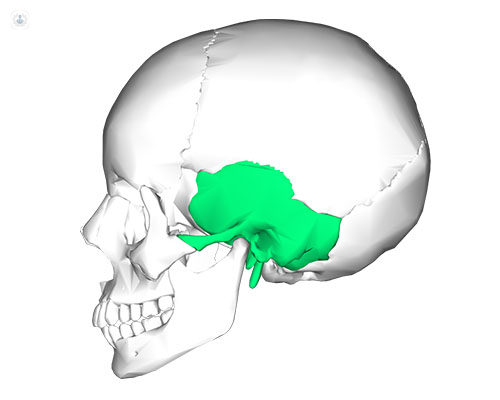

What is microsurgery of the temporal bone?
Temporal bone microsurgery is the surgical procedure performed on the delicate bones that make up the side of and the base of the skull. The temporal bone consists of four parts: the squamous, mastoid, petrous and tympanic parts.
Temporal bone functions include:
- Protect the encephalon and auditory organs.
- Provide part of the joint surfaces for the temporomandibular joint.
- It is part of the temporal region and the temporary fossa.
As the temporal bone has the tympanic cavity and the Eustachian tube in it, it is often associated with ear related disorders, such as tinnitus or ringing in the ears, dizziness, and Ménière’s disease.

Why is microsurgery necessary in some cases?
Temporal bone microsurgery may be carried out due to an ear disorder or if there has been a trauma to the temporal bone. In fact, fractures are the most common injury. If the fracture can’t properly be seen, there are certain signs that doctors look out for:
- Soft tissue invasion within mastoid cells or in the tympanic cavity and air in unusual places. The ossicular chain can be dislocated or injured due to a luxation or a fracture, which will be analysed by CT scan.
- Injuries that affect the skull are the most common reason for problems of the temporal bone, especially direct hits, foreign bodies, or penetrating wounds. When there is a temporal bone fracture there has been a trauma, which is why it is often linked to other skull fractures.
What does it involve?
Temporal bone dissection is a complex procedure for otologists, neuro-otologists, and ear/skull surgeons. It is essential for the surgeon to have surgical skills and knowledge in order to be able to adequately manage diseases that affect this bone. There are different surgical procedures depending on what the issues are. These include:
- Simple mastoidectomy: removal of the mastoid cells, the air-filled spaces in the skull behind the ear. In most cases, it is a condition caused by an ear infection and that spreads to the surrounding bone in the skull.
- Posterior tympanostomy: opening the facial recess by mastoidectomy to communicate the middle ear with the mastoid. It is a posterior ear cavity surgery. It enables direct access and treatment of the pathological processes located in said cavities, while also giving access to other cavities such as the epitympanum and the eardrum.
How to prepare for microsurgery of the temporal bone
Depending on the procedure to be carried out, the specialist will recommend different pre-procedural instructions. A CT scan will be done to get an idea of the depth and type of lesion. Once diagnosed, an otorhinolaryngologist will recommend what steps the patient should take.
Post-operative care
Certain precautions will be necessary after surgery because the surgical site is sensitive as it includes the skull and other fragile bones such as the ones that make up the auditory structures. The otorhinolaryngologist will recommend the appropriate post-operative care.
Alternative treatments
Progress is being continually made in finding minimally invasive procedures, and the subspecialty of temporal bone surgery is no exception. It is a very delicate area, with many nerve endings and sensitive structures, meaning that the less invasive surgery is, the better.
